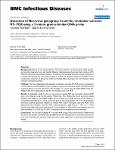Detection of Norovirus genogroup I and II by multiplex real-time RT- PCR using a 3'-minor groove binder-DNA probe
Hoehne, Marina
Schreier, Eckart
Background: Due to an increasing number of norovirus infections in the last years rapid, specific, and sensitive diagnostic tools are needed. Reverse transcriptase-polymerase chain reactions (RT-PCR) have become the methods of choice. To minimize the working time and the risk of carryover contamination during the multi-step procedure of PCR the multiplex real-time RT-PCR for the simultaneous detection of genogroup I (GI) and II (GII) offers advantages for the handling of large amounts of clinical specimens. Methods: We have developed and evaluated a multiplex one-tube RT-PCR using a combination of optimized GI and GII specific primers located in the junction between ORF1 and ORF2 of the norovirus genome. For the detection of GI samples, a 3'-minor groove binder-DNA probe (GI-MGB-probe) were designed and used for the multiplex real-time PCR. Results: Comparable results to those of our in-house nested PCR and monoplex real-time-PCR were only obtained using the GI specific MGB-probe. The MGB-probe forms extremely stable duplexes with single-stranded DNA targets, which enabled us to design a shorter probe (length 15 nucleotides) hybridizing to a more conserved part of the GI sequences. 97% of 100 previously norovirus positive specimens (tested by nested PCR and/or monoplex real-time PCR) were detected by the multiplex real-time PCR. A broad dynamic range from 2 x 10(1) to 2 x 10(7) genomic equivalents per assay using plasmid DNA standards for GI and GII were obtained and viral loads between 2.5 x 10(2) and 2 x 10(12) copies per ml stool suspension were detected. Conclusion: The one-tube multiplex RT real-time PCR using a minor groove binder-DNA probe for GI is a fast, specific, sensitive and cost-effective tool for the detection of norovirus infections in both mass outbreaks and sporadic cases and may have also applications in food and environmental testing.
No license information

